Standing in the bustling streets of Kathmandu, it's hard not to wonder: can you actually glimpse the world's highest peak from Nepal's capital city? This question captivates the imagination of travelers who arrive in Kathmandu with dreams of witnessing the majestic Mount Everest. While the answer isn't a simple yes or no, the quest to view this iconic mountain from Kathmandu reveals a fascinating journey through Nepal's geography, optimal viewpoints, and seasonal considerations that can make all the difference between disappointment and awe.
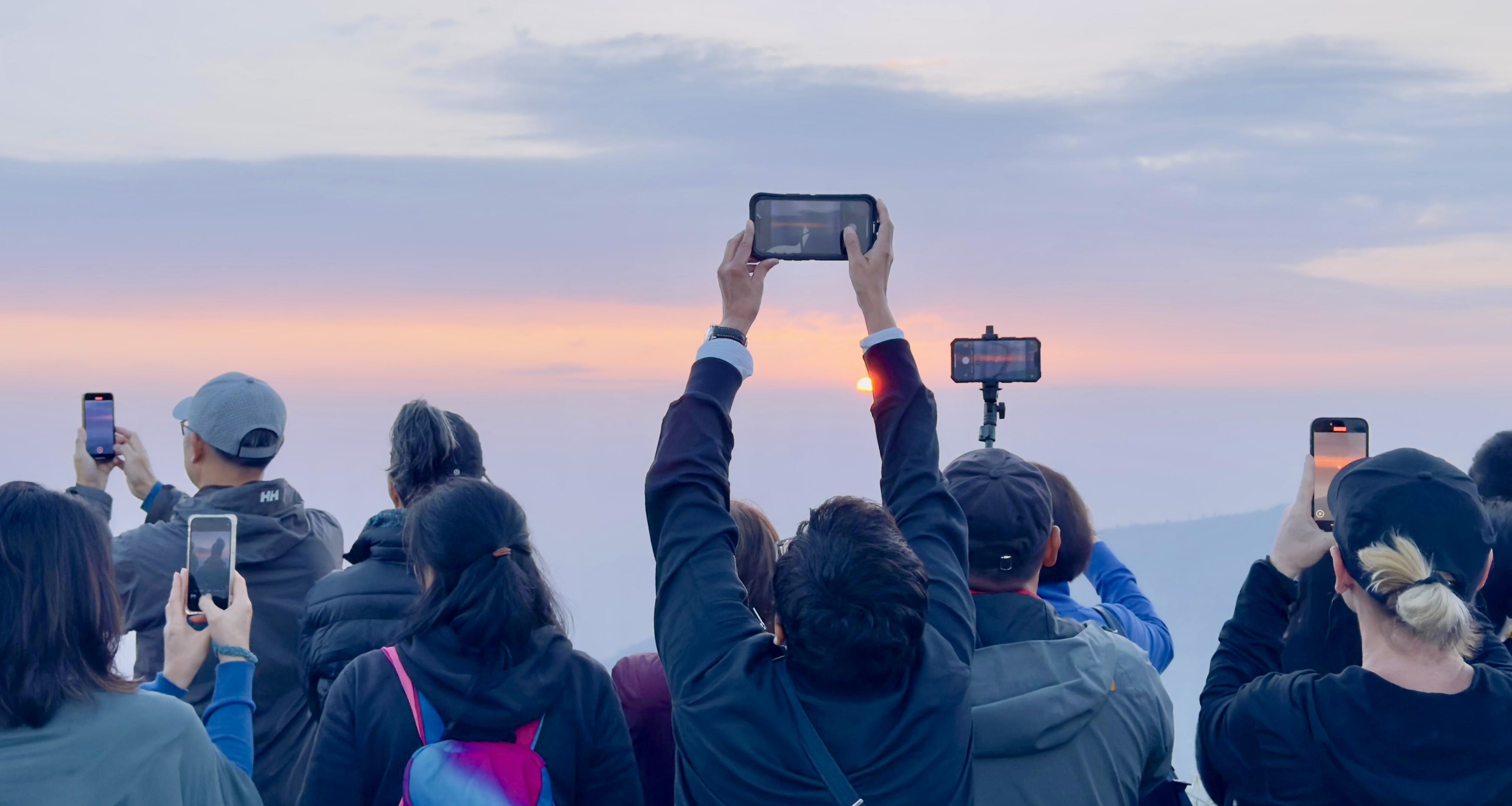
At Luxury Holidays Nepal, we understand the magnetic pull of Everest's grandeur. Whether you're planning a full expedition or simply hoping to capture a photograph of this legendary peak, the thrill of seeing Everest with your own eyes is unparalleled. While Everest isn't directly visible from central Kathmandu, we've spent years helping travelers discover the perfect vantage points just outside the city, like Nagarkot (approximately 20 miles away), where on clear days, the mountain's distinctive peak emerges on the horizon. For those seeking closer encounters without the challenge of trekking, our specially designed viewing experiences offer alternatives that bring you face-to-face with the "roof of the world."
In this comprehensive guide, we'll explore the geographical relationship between Kathmandu and Mount Everest, reveal the best viewpoints for spectacular sightings, share the optimal times for clear visibility, provide expert photography tips, introduce you to immersive experiences in the Everest region, and highlight luxury accommodations that offer breathtaking Himalayan panoramas. Join us as we unravel the secrets to witnessing one of nature's most magnificent creations from the comfort of Kathmandu and its surroundings.
The Geographical Relationship Between Kathmandu and Mount Everest
The Distance From Kathmandu to Mount Everest
Mount Everest sits about 85 miles (137 kilometers) northeast of Kathmandu as the crow flies. That might not sound too far, but in the rugged Himalayan terrain, it's quite a journey. We often tell our guests that while Everest seems close on a map, reaching the mountain's base camp takes around 7-10 days of trekking after a flight to Lukla from Kathmandu.
The straight-line distance is deceiving because the actual travel routes wind through valleys, around mountains, and across challenging landscapes. If you tried to drive (which isn't possible all the way), you'd need to cover approximately 190 miles (305 kilometers) on winding mountain roads - and even then, you'd still need to trek for several days to get close to Everest.
Topographical Features Affecting Visibility
The Kathmandu Valley sits at an elevation of about 4,600 feet (1,400 meters), while Everest towers at 29,032 feet (8,849 meters). This massive height difference should make Everest easy to spot, right? Not exactly.
Several mountain ranges stand between Kathmandu and Everest, creating natural barriers. The Mahalangur range, where Everest is located, is blocked from view by the Rolwaling and Langtang ranges. These closer mountains, though smaller than Everest, effectively screen it from our view in the city.
The valley's bowl shape also plays a role. We're surrounded by hills ranging from 5,000-9,000 feet (1,500-2,700 meters), creating a natural wall around the city that limits long-distance visibility in many directions.
Weather Conditions and Their Impact on Visibility
The weather dramatically affects whether we can catch a glimpse of distant peaks. During monsoon season (June to September), heavy clouds blanket the mountains, making visibility nearly impossible. Even in the dry season, morning fog and afternoon haze often obscure distant views.
The best time for mountain viewing is typically early morning during the pre-monsoon (March-May) and post-monsoon (October-November) seasons. These periods offer the clearest skies with less atmospheric moisture.
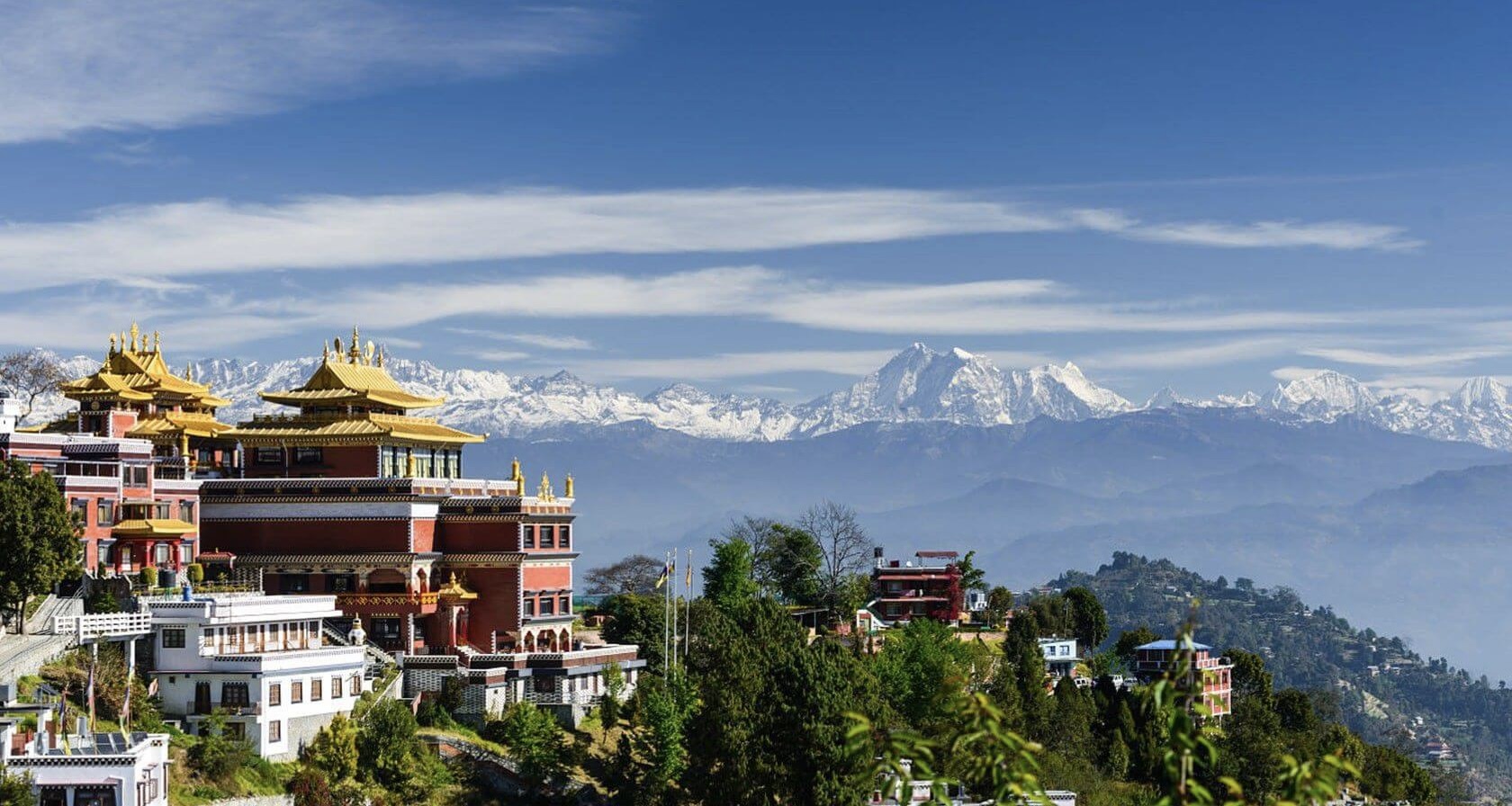
Sometimes, after a heavy rainfall washes away dust and pollution, we enjoy unusually clear conditions. On these rare days, the distant Himalayan peaks appear with stunning clarity, though Everest itself remains difficult to identify due to its position among other tall peaks.
Air Quality Considerations in Kathmandu Valley
Air quality in our valley has become a significant factor affecting visibility. Kathmandu's rapid urbanization has led to increased vehicle emissions, construction dust, and industrial pollution. During winter months (December-February), temperature inversions trap pollutants in the valley, creating a thick haze that can reduce visibility to just a few kilometers.
This pollution layer often prevents us from seeing even the closer mountains surrounding the valley, let alone distant peaks like Everest. The Air Quality Index (AQI) in Kathmandu frequently reaches unhealthy levels, especially during dry winter days when there's little wind to disperse pollutants.
We've noticed a direct correlation between air quality measurements and mountain visibility. When the AQI drops below 50 (good), the chances of seeing distant mountains improve dramatically. Unfortunately, such days have become increasingly rare in recent years.
Best Viewpoints for Mount Everest from Kathmandu
Nagarkot: The Premier Viewing Location
Nagarkot stands tall as the crown jewel for Everest viewing near Kathmandu. Perched at an impressive elevation of 2,175 meters, this hill station offers what we consider the most reliable views of Mount Everest when weather conditions cooperate.
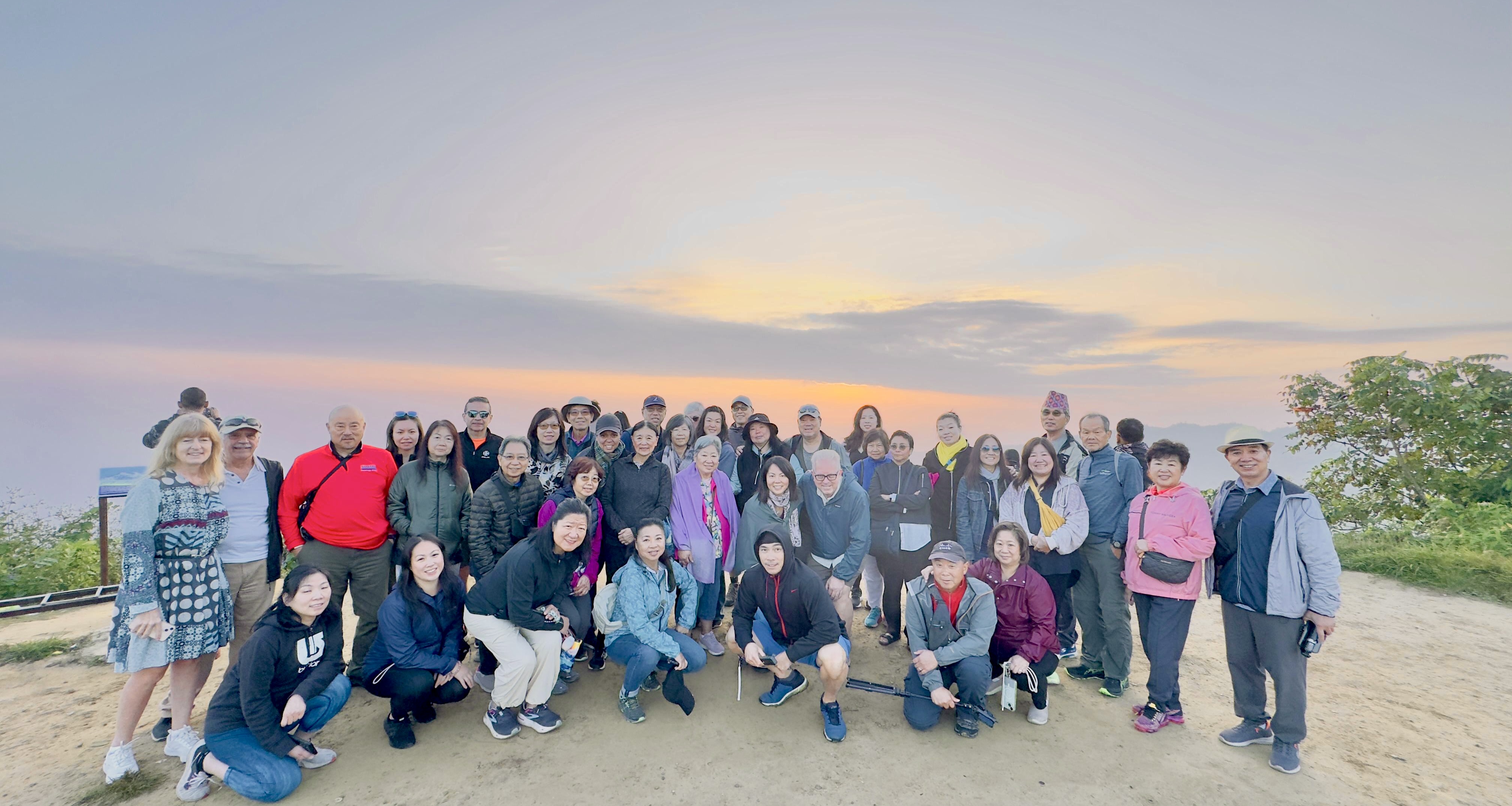
We've found that early mornings (5:00-7:00 AM) provide the clearest visibility, especially during the October-December and February-April windows. The panorama from Nagarkot doesn't just feature Everest – we're talking about breathtaking views of other peaks like Langtang, Ganesh Himal, and Dorje Lakpa that create a mesmerizing 200+ kilometer stretch of Himalayan magnificence.
The viewing tower at Nagarkot gives us an elevated platform that makes spotting Everest easier. Just look for the distinctive pyramid peak in the northeast – that's the world's highest mountain in all its glory!
Chandragiri Hills: A Panoramic Experience
The Chandragiri Hills have become one of our favorite spots since the cable car opened in 2016. Sitting at 2,551 meters, this viewpoint offers a unique perspective of both the Kathmandu Valley and the Himalayan range, including Everest.
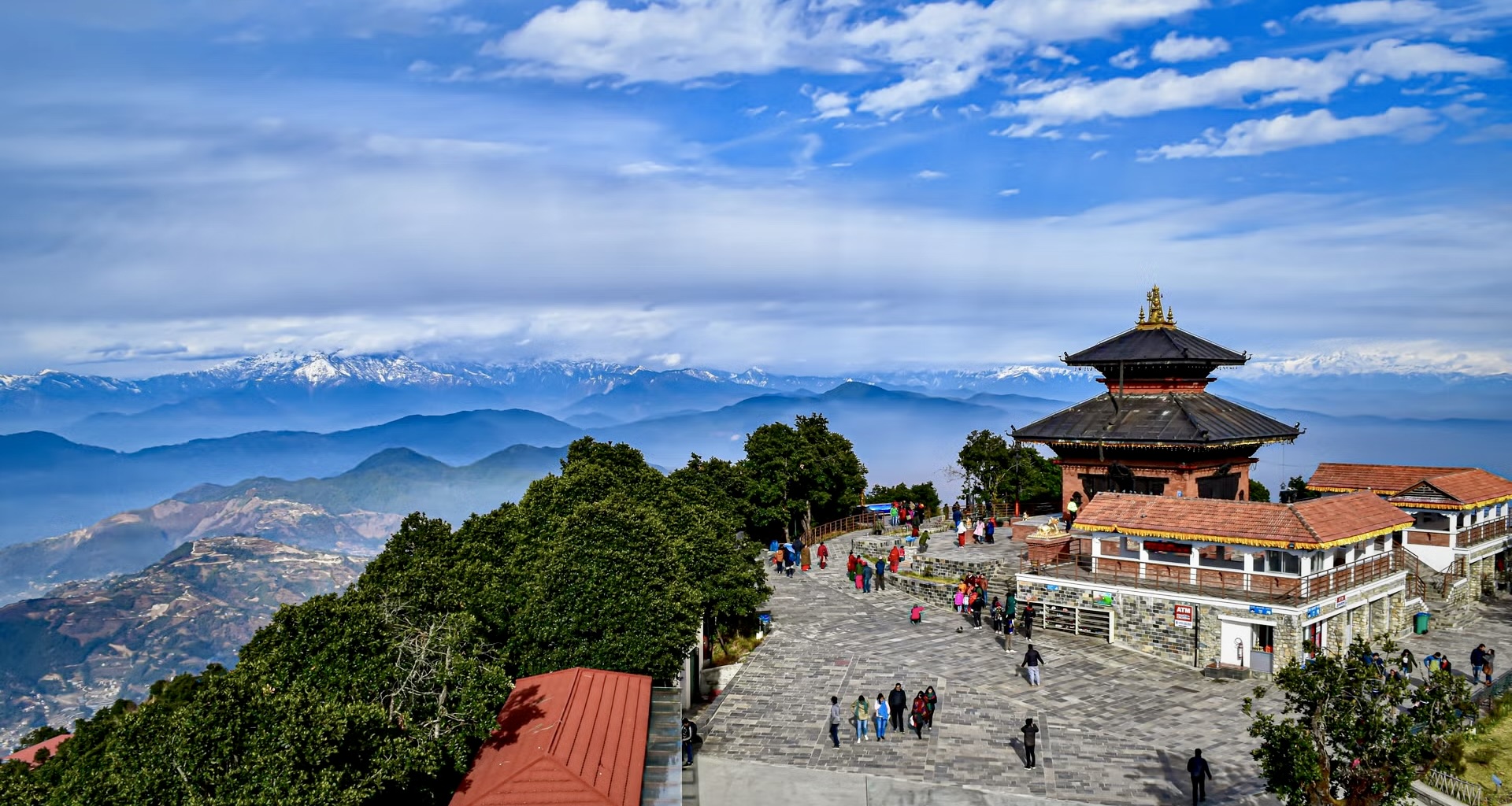
We love taking the 12-minute cable car ride that whisks us from the base station to the summit. The experience isn't just about mountain views – we get to enjoy the Baleshwar Temple, several restaurants, and even a mini amusement park at the top.
On crystal-clear days, Everest appears as a distant but distinct peak on the northeastern horizon. The cable car operates from 8:00 AM to 5:00 PM, and we suggest arriving early to avoid the crowds.
Kakani: The Less Crowded Alternative
Kakani might fly under the radar for most tourists, but we consider it a hidden gem. Located about 29 kilometers northwest of Kathmandu at an altitude of 2,073 meters, it offers magnificent views of the Ganesh Himal, Langtang, and yes, Mount Everest on clear days.
What we appreciate most about Kakani is the peace and quiet. While Nagarkot and Chandragiri buzz with tourists, here we can enjoy the mountain panorama in relative solitude. The fresh air, scented with pine from the surrounding forests, makes the viewing experience even more special.
The Nepal Mountaineering Association has established a memorial park here dedicated to climbers who lost their lives on Himalayan expeditions – a sobering reminder of the mountains' majesty and danger.
We typically reach Kakani via a 90-minute drive from Kathmandu. There's no entrance fee, making it a budget-friendly option for Everest viewing.
Champadevi: For Adventure Seekers
For those of us who enjoy combining hiking with mountain viewing, Champadevi hits the sweet spot. Standing at 2,285 meters, this hill on the southwestern rim of the Kathmandu Valley rewards energetic travelers with spectacular panoramic views.
The hike takes us about 3-4 hours from the starting point at Pharping, following a trail through beautiful forests and past Buddhist and Hindu shrines. The path isn't technically difficult, but the steady climb definitely gets our hearts pumping!
On reaching the summit, we're treated to views of the Kathmandu Valley on one side and the Himalayan range, including Everest in the distance, on the other. The best part? The satisfaction of earning those views through our own effort.
We always pack plenty of water, snacks, and sun protection for this journey. The trail can get busy on weekends with local hikers, so weekdays offer a more peaceful experience.
Hotel Rooftops and Observation Decks in Kathmandu
Sometimes we don't even need to leave the city to catch a glimpse of Everest. Several high-rise hotels and dedicated observation points within Kathmandu offer distant views of the mountain on exceptionally clear days.
Our top picks include:
- Hotel Everest View Terrace: Despite the name, this rooftop restaurant offers only occasional Everest sightings, but the panoramic city views make up for it.
- Chandragiri Cable Car's Observation Tower: The highest viewing platform in the Kathmandu Valley region.
- The Deck at Karma Boutique Hotel: A hidden gem with complimentary telescopes for guests.
- Shivapuri Heights: This eco-lodge on the northern edge of the valley combines comfort with mountain views.
For the best chances of spotting Everest from these urban viewpoints, we visit during winter mornings when air pollution is at its lowest. Nothing beats sipping a hot cup of Nepali tea while gazing at the world's highest peak!
Optimal Times to See Mount Everest
Seasonal Visibility Patterns
We've spent years guiding travelers through Nepal, and one thing's for sure - timing is everything when trying to spot Mount Everest from Kathmandu. The mountain plays hide-and-seek with us throughout the year, following predictable patterns.
During monsoon season (June-August), we rarely catch glimpses of Everest. Thick clouds blanket the mountains, and heavy rainfall reduces visibility to practically zero. It's like the Himalayas take a vacation from view!
The post-monsoon period (September-November) brings dramatic improvements. As the rains retreat, we enjoy crystal-clear skies, especially in October and November. The air feels fresher, washed clean by the monsoons, making this our favorite time to spot the mighty peak.
Winter (December-February) offers excellent visibility too, though occasional weather systems can temporarily obscure the views. The crisp, dry air of winter mornings creates perfect conditions for mountain gazing.
Pre-monsoon (March-May) starts wonderfully but gradually deteriorates. March and April give us some spectacular mornings, but by late May, approaching monsoon clouds begin to hide the mountains again.
Best Months for Clear Mountain Views
We've tracked mountain visibility for years, and October and November consistently rank at the top of our list. The air clarity following the monsoon season is simply unmatched. December through February follows closely behind, offering spectacular viewing opportunities on clear days.
Here's our month-by-month visibility rating:
|
Month |
Visibility Rating |
Notes |
|
October |
Excellent (9/10) |
Post-monsoon clarity; consistent views |
|
November |
Excellent (9/10) |
Crisp, clear days; optimal conditions |
|
December |
Very Good (8/10) |
Clear but can be hazy some mornings |
|
January |
Very Good (8/10) |
Cold, clear days with excellent visibility |
|
February |
Good (7/10) |
Generally clear but increasing haze |
|
March |
Good (7/10) |
Clear mornings, afternoon haze increases |
|
April |
Fair (6/10) |
Morning views possible; afternoon clouds common |
|
May |
Poor (4/10) |
Pre-monsoon haze and clouds developing |
|
June-September |
Very Poor (2/10) |
Monsoon clouds obscure mountains most days |
Ideal Time of Day for Maximum Visibility
The early bird truly catches the Everest view! We always recommend our guests set their alarms for dawn. The magic hours are between 5:00 AM and 8:00 AM when the air is stillest and clearest.
As the day progresses, thermal winds kick up dust and pollution, creating a haze that obscures the mountains. By afternoon, especially during warmer months, cloud formation around the peaks makes sightings much more difficult.
Another good viewing window opens briefly before sunset, around 5:00-6:00 PM, particularly during winter months when the air tends to be clearer throughout the day.
Weather Forecasting Resources for Travelers
We never leave mountain viewing to chance! Before heading to viewpoints, we check these reliable forecasting tools:
- The Nepal Department of Hydrology and Meteorology website provides accurate local forecasts specifically for mountain regions. Their satellite imagery gives real-time cloud cover information, crucial for planning your viewing trip.
- For tech-savvy travelers, we recommend downloading the Windy app, which offers detailed visualization of cloud patterns and visibility forecasts, specifically useful for mountain viewing.
- Weather News Nepal on social media often posts up-to-the-minute reports about visibility conditions in Kathmandu Valley, sometimes even sharing recent Everest view photos from various locations.
- Local knowledge remains invaluable - we always suggest asking your hotel staff or tour guides about conditions before making early morning treks to viewpoints.
Photography Tips for Capturing Mount Everest from Kathmandu
Essential Camera Equipment for Mountain Photography
Ever tried snapping a photo of Mount Everest only to end up with a tiny bump on the horizon? We've been there too. The right gear makes all the difference when photographing Everest from Kathmandu.
First up, you'll need a DSLR or mirrorless camera with good resolution. Those smartphone cameras? Not gonna cut it for distant mountain photography. We recommend at least a 24MP sensor to capture those fine details.
The real game-changer is your lens choice. A telephoto lens with a 200-600mm range is our go-to for bringing those distant peaks closer. Remember, Everest sits about 140 miles from Kathmandu!
Don't forget these essentials:
- A rock-solid tripod (those long lenses get heavy)
- Circular polarizing filter (cuts through haze)
- UV filter (reduces atmospheric blue)
- Remote shutter release (eliminates camera shake)
- Extra batteries (cold weather drains them fast)
Our favorite setup? The Sony A7R IV, paired with a 200-600mm G Master lens, gives us incredible results. Not in your budget? No worries. Even a basic 70-300mm on a crop sensor camera will work better than nothing.
Composition Techniques for Distant Mountain Shots
Getting that jaw-dropping shot of Everest isn't just about equipment. Composition makes or breaks your mountain photography.
The rule of thirds works wonders here. We position Everest at one of the intersecting points rather than dead center. This creates more dynamic images that draw the viewer's eye naturally.
Foreground elements are your secret weapon. Including prayer flags, stupas, or even tree branches in your frame provides scale and depth. Without these, mountains often appear flat and unimpressive in photos.
Layering is another technique we swear by. Try capturing multiple mountain ranges leading up to Everest. This creates depth and shows the true majesty of the Himalayas.
Want a pro tip? Look for reflections. If you're near a lake or even a small puddle after rain, you can capture Everest twice in one frame. Those reflection shots consistently perform best on our social media.
The best compositions often include:
- Natural frames (tree branches, windows, archways)
- Leading lines (roads, rivers pointing toward the mountain)
- Human elements for scale (just a tiny figure against the massive peaks)
Dealing with Atmospheric Haze and Lighting Challenges
Let's talk about the elephant in the room: Kathmandu's notorious haze. It's the number one enemy of clear mountain photography.
The timing of your shoot is everything. We've found the best visibility occurs between 6-8 AM, especially during October-November and March-April. The air is clearest after rainfall when dust particles have been washed away.
Shooting with the sun at your back helps tremendously. When the sun is behind you illuminating the mountains, you'll get much better contrast and detail than shooting toward the light.
Filters are your best friends in hazy conditions. We always pack:
- Polarizing filters (reduce atmospheric scatter)
- Graduated ND filters (balance bright skies with darker foregrounds)
- Yellow/orange filters (increase contrast when shooting in black and white)
Another trick we use: shooting from higher elevations within the valley. Locations like Nagarkot or Chandragiri Hills get you above some of the lower atmosphere haze.
The hardest lighting challenge? That brief golden hour when Everest glows orange at sunrise. To capture this, we typically underexpose slightly to preserve those vibrant colors.
Post-Processing Tips for Mountain Visibility Enhancement
Even with perfect timing and equipment, most Everest shots need some post-processing love. We're not talking about fake-looking edits, just enhancements that reveal what your eyes actually saw.
Contrast adjustments are your starting point. We typically increase the overall contrast while protecting the highlights. This makes the mountain ridges pop against the sky.
The dehaze slider (available in Lightroom and most editing software) is practically made for Kathmandu mountain photography. A value between 20 and 40 usually works wonders without looking artificial.
Color temperature tweaks help too. We often cool down the image slightly, shifting toward the blue end of the spectrum. This reduces the yellowish cast that haze creates.
For the most natural-looking results, we use these targeted adjustments:
- Clarity boost on the mountains only (using a mask)
- Subtle sharpening of the peaks and ridges
- Slight reduction in highlights to recover detail in snow
- Careful noise reduction that preserves texture
One last tip we've discovered: converting to black and white can sometimes reveal Everest when color processing fails. The mountain's distinctive pyramid shape stands out dramatically against the sky when color distractions are removed.
Beyond the View: Experiencing the Everest Region
Scenic Flights: Getting Closer to Everest
While catching glimpses of Everest from Kathmandu is possible on clear days, nothing compares to the thrill of a mountain flight. We've arranged these flights for thousands of visitors, and the experience never gets old. For about $200-250, you'll board a small aircraft early morning (typically between 6-9 AM) for a spectacular one-hour journey that brings you face-to-face with the Himalayan giants.
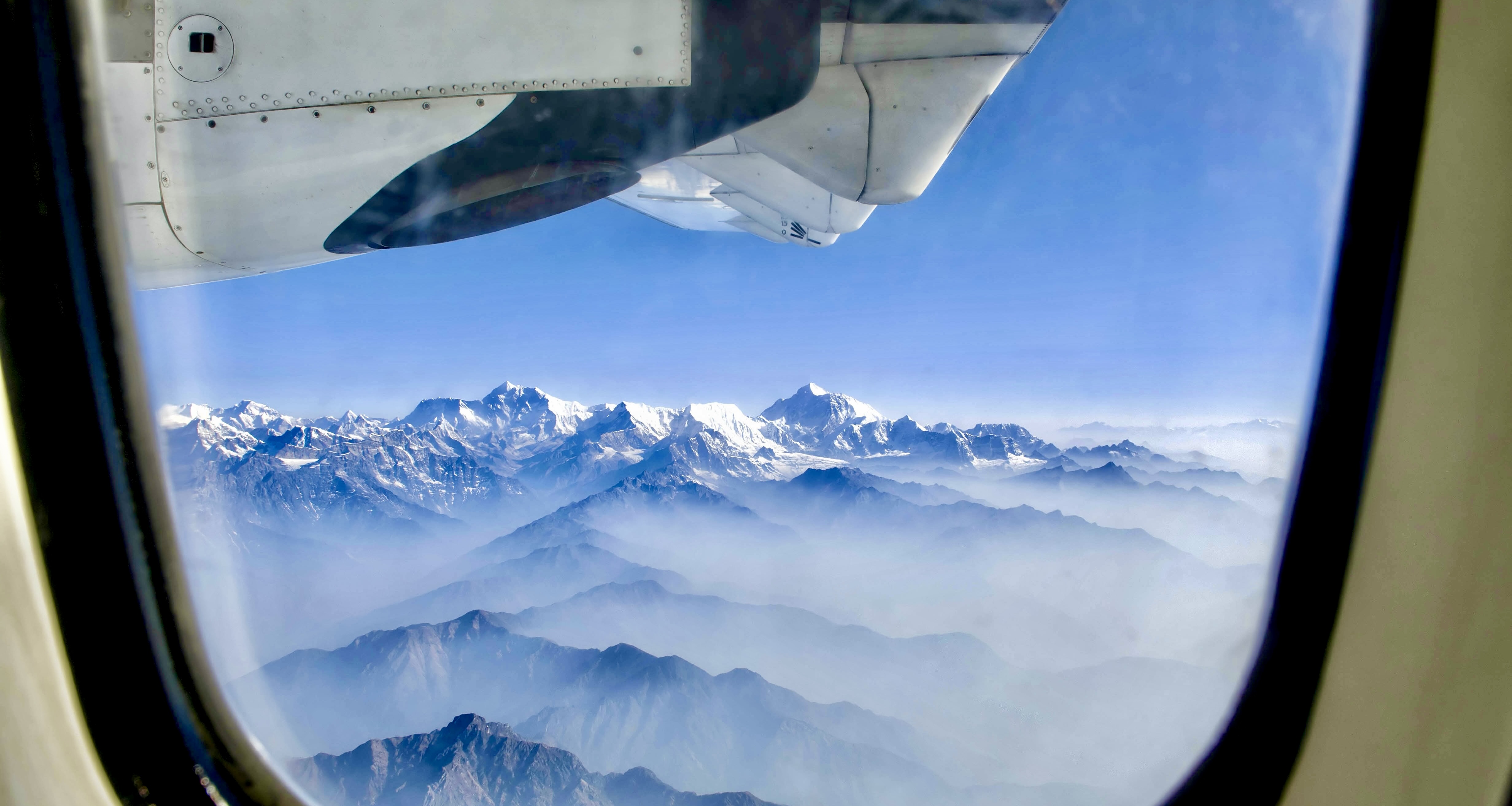
The best part? Every passenger gets a window seat. When that magnificent peak comes into view, the pilot announces it, and you'll even get invited to the cockpit for that perfect photo opportunity. Trust us, the aerial perspective of Everest and surrounding peaks like Lhotse, Nuptse, and Makalu is absolutely breathtaking.
Day Trips to Enhance Your Mountain Viewing Experience
Not everyone has time for extensive treks, which is why we've perfected several day trips from Kathmandu that offer stunning mountain views. Nagarkot, just 32 km from the city, sits at 2,175m and offers panoramic vistas that often include Everest on crystal clear mornings.
Alternatively, we recommend Chandragiri Hills, accessible via cable car, or Phulchowki, the highest hill around Kathmandu Valley. These spots are perfect for travelers with limited time but unlimited appreciation for mountain scenery. We typically pair these trips with cultural experiences, creating full-day excursions that showcase both Nepal's natural beauty and rich heritage.
Multi-Day Trekking Options from Kathmandu
For those with adventure in their hearts, we organize several multi-day treks that progressively bring you closer to Everest. The classic Everest Base Camp trek spans 12-14 days, starting with a flight to Lukla from Kathmandu. This journey takes you through charming Sherpa villages, ancient monasteries, and ultimately to 5,364m, where climbers begin their summit attempts.
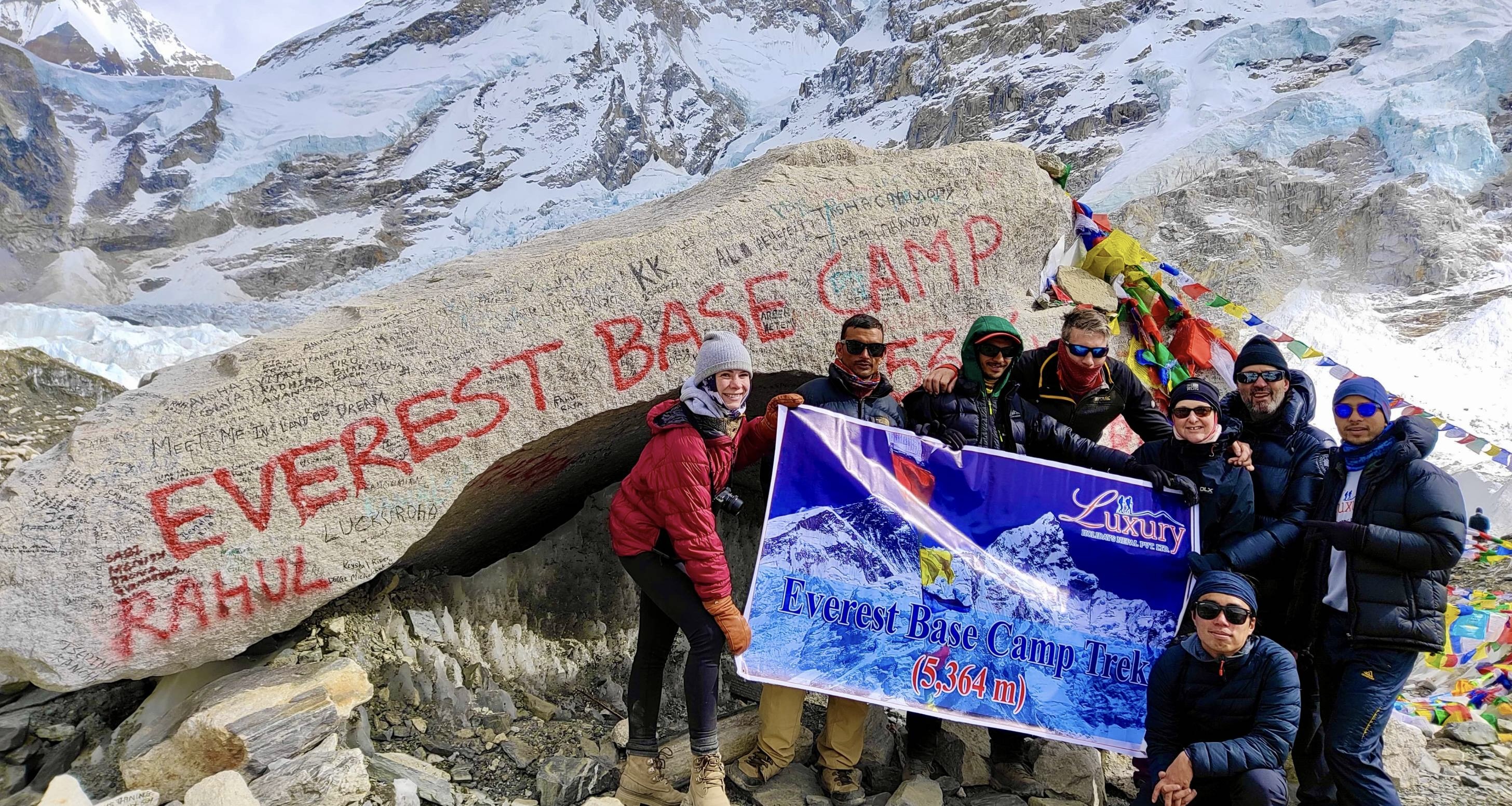
If you're pressed for time, we recommend our 5-7 day Everest View Trek, which still delivers incredible mountain panoramas without reaching the higher altitudes. For something truly special, our helicopter tours combine flying and short treks, giving you the ultimate flexibility.
Cultural Connections to the Mountain in Kathmandu
You don't actually need to see Everest to feel its presence in Kathmandu. We always take our guests to explore the city's deep cultural connections to the mountains. The Sherpa culture museum provides fascinating insights into the lives of these legendary mountain people. At Boudhanath and Swayambhunath, two ancient Buddhist stupas, you'll witness pilgrims and monks performing rituals that have connected humans to these sacred peaks for centuries.
Don't miss Durbar Square, where traditional wood carvings often depict mountain deities. We've found that understanding these cultural connections enriches the entire Everest experience, even before you catch your first glimpse of the mountain itself.
Luxury Accommodations with Everest Views
Premium Hotels with Mountain-Facing Rooms
We've partnered with some of the finest hotels in Kathmandu that offer those jaw-dropping mountain views you're dreaming about. The Hyatt Regency Kathmandu features specially designed rooms with panoramic windows that frame distant Himalayan peaks on clear days. Their top-floor suites come with private balconies where you can sip morning coffee while catching glimpses of the majestic mountains.
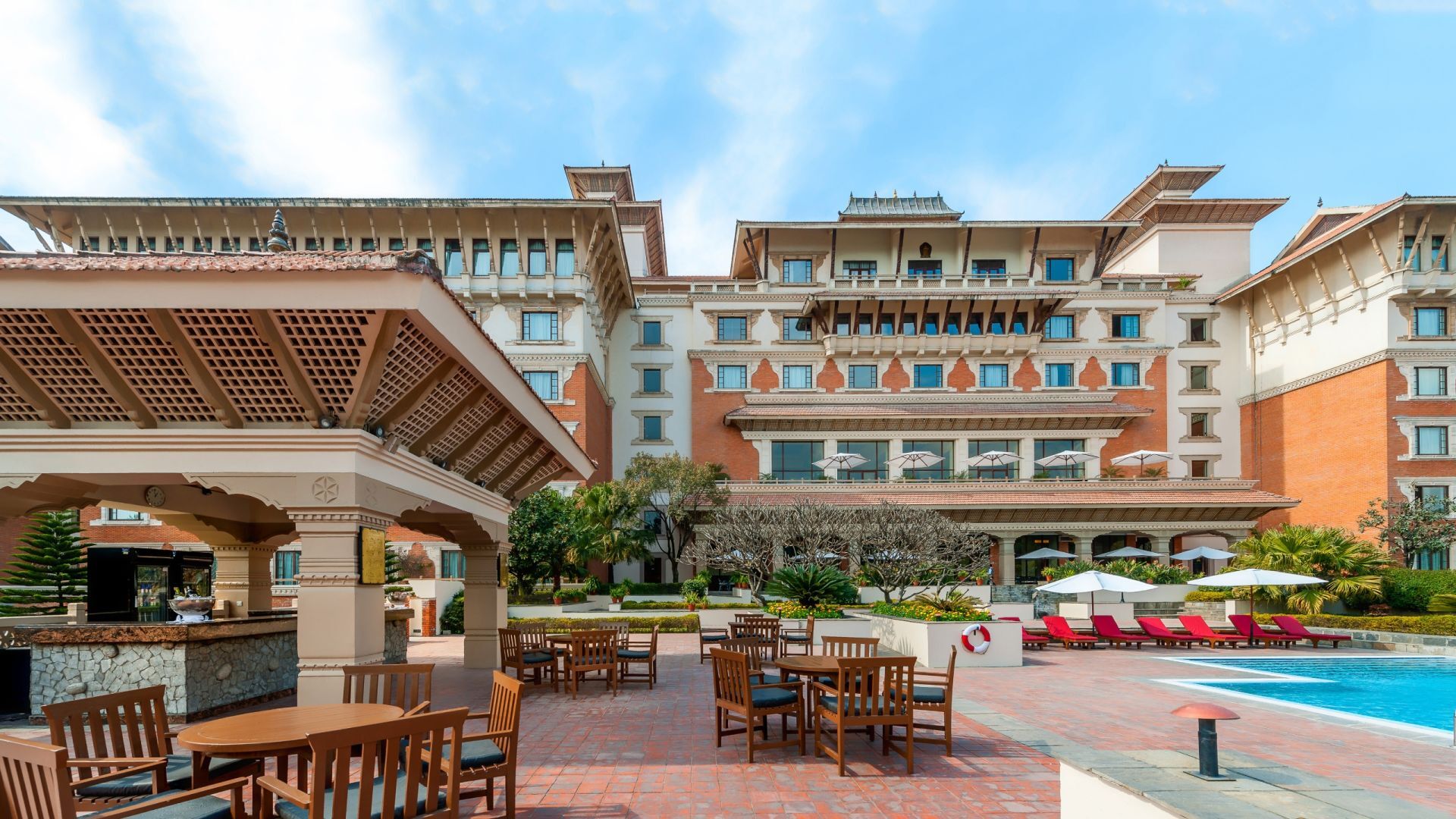
The Dwarika's Hotel, our personal favorite for luxury-seekers, combines traditional Newari architecture with modern comforts. Their heritage mountain-view rooms offer a unique perspective of the Kathmandu Valley with the Himalayas serving as a dramatic backdrop. Trust us, there's nothing like waking up to that view!
Boutique Resorts in Nagarkot and Dhulikhel
Just an hour's drive from Kathmandu, we highly recommend these two hillside towns for serious Everest viewers. Club Himalaya in Nagarkot sits at 7,200 feet and offers one of the most spectacular mountain panoramas anywhere. Their 360-degree view rooms give you unobstructed vistas of Everest and other peaks.
In Dhulikhel, Dwarika's Resort provides luxury with a view. We love their meditation deck where the mountains seem close enough to touch during sunrise. The floor-to-ceiling windows in their mountain-facing suites create the illusion that you're floating among the Himalayas.
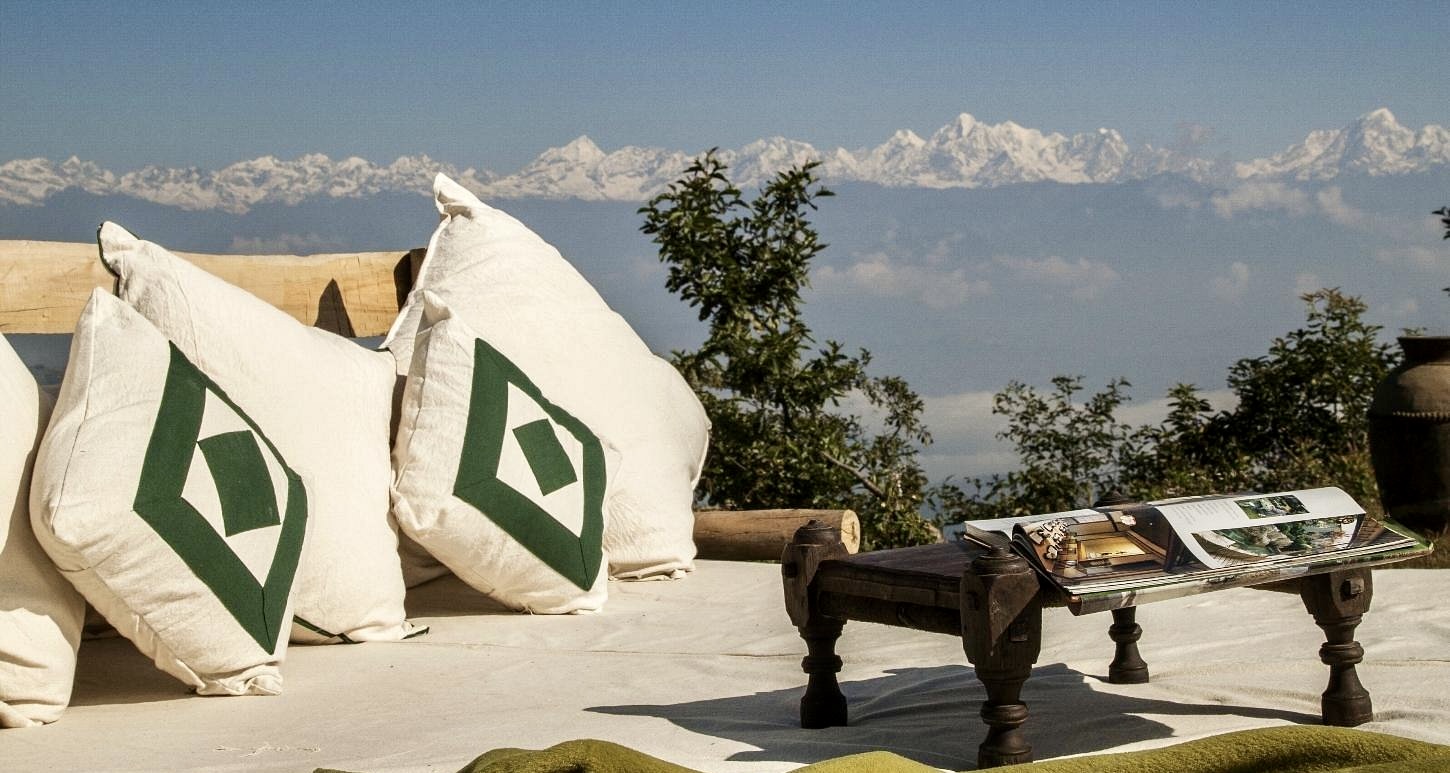
Exclusive Services for Mountain Viewing Experiences
We understand that mountain viewing requires perfect timing and conditions. That's why we arrange exclusive wake-up calls for our guests during optimal viewing hours. Many of our partner hotels offer dedicated mountain guides who can identify each peak and share fascinating stories about it.
The Gokarna Forest Resort provides private sunrise mountain-viewing tours with breakfast served on their observation deck. We've also arranged telescope installations in select luxury accommodations so you can get that perfect close-up of Everest's peak.
Combining Comfort and Nature: Luxury Mountain Lodges
We're huge fans of the newer luxury lodges popping up on the hills surrounding Kathmandu. The Himalayan Front Hotel by KGH Group offers heated infinity pools facing the mountain range – imagine floating in warm water while gazing at snow-capped Everest!
For the ultimate experience, we recommend Kasara Resort near Chitwan, which combines jungle luxury with mountain views. Their private villas feature expansive viewing decks where you can enjoy personalized dining while watching the sunset paint Everest in golden hues. Their "Mountain Meditation" package includes yoga sessions facing the Himalayas at dawn – pure magic for the soul.
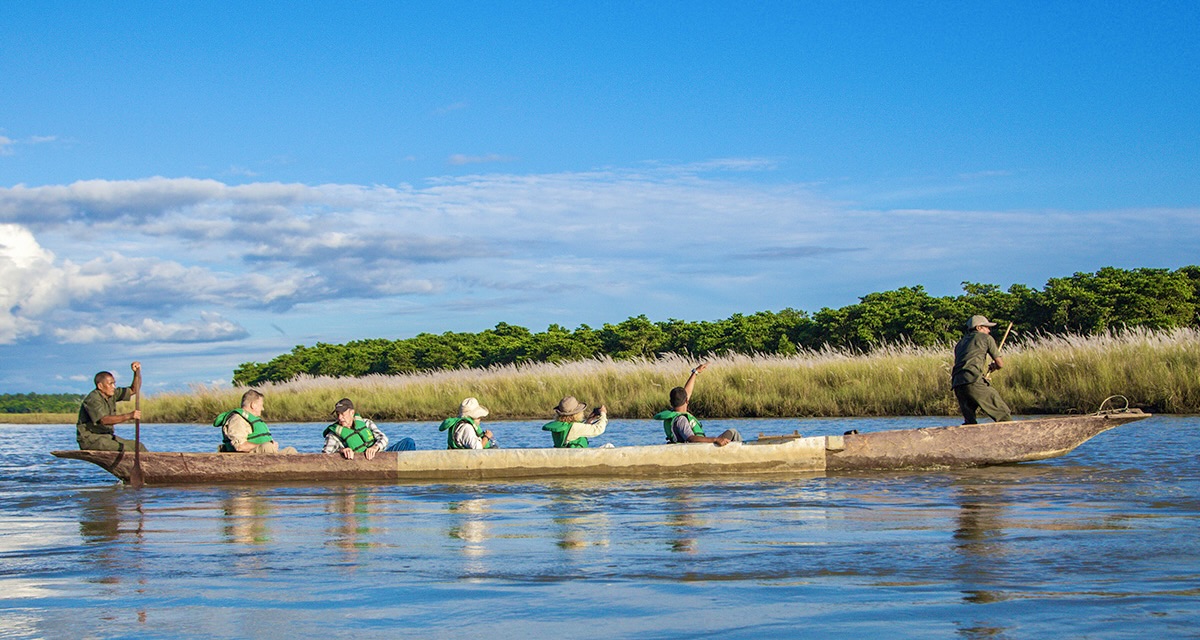
Experiencing the Majesty of Mount Everest
While Mount Everest isn't directly visible from Kathmandu's city center, we hope this guide has shown you that glimpsing the world's highest peak is still very much achievable during your Nepal visit. Whether you choose to venture to nearby viewpoints like Nagarkot, time your visit during the clear winter months, book a mountain flight, or embark on one of our luxury trekking experiences, the sight of Everest's magnificent peak is within your reach.
At Luxury Holidays Nepal, we believe that witnessing Mount Everest is more than just seeing a mountain—it's about experiencing the cultural richness of the Himalayas, staying in premium accommodations with spectacular views, and creating memories that will last a lifetime. From photography enthusiasts capturing the perfect sunrise shot to adventurers seeking to stand at Everest Base Camp, we're here to customize your perfect Everest experience. Contact us today to transform your dream of seeing the roof of the world into reality.
If you need any further information, please contact us by email: [email protected], Phone: +977- 985 100 5129 (WhatsApp).




